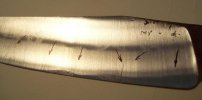- Joined
- Jun 25, 2007
- Messages
- 898
I understand the some of the ideas that make water quenching safer; like 1475-1500F, 1/16-3/32 edge thickness, and 3 seconds in 2 out (repeat 3 times then get that sucker in the preheated oven fast). I haven't seen any information on what temperature the water should be at for the quench though, any help fellas?
Yes I am crazy and I expect a 50% fail rate but I only want to water quench display knives that could use the extra detail in the hamon.
Is polishing the curve of the plunge line important? It seems like you could take it to 400grit and stop while taking the rest of the blade to 2000+grit and you would not notice much contrast because the sharp curve would make it hard to observe the polish. Also I don't know where to get sandpaper up to 8000grit to match the waterstones, is there any out there?
Thanks
-Dan
Yes I am crazy and I expect a 50% fail rate but I only want to water quench display knives that could use the extra detail in the hamon.
Is polishing the curve of the plunge line important? It seems like you could take it to 400grit and stop while taking the rest of the blade to 2000+grit and you would not notice much contrast because the sharp curve would make it hard to observe the polish. Also I don't know where to get sandpaper up to 8000grit to match the waterstones, is there any out there?
Thanks
-Dan

